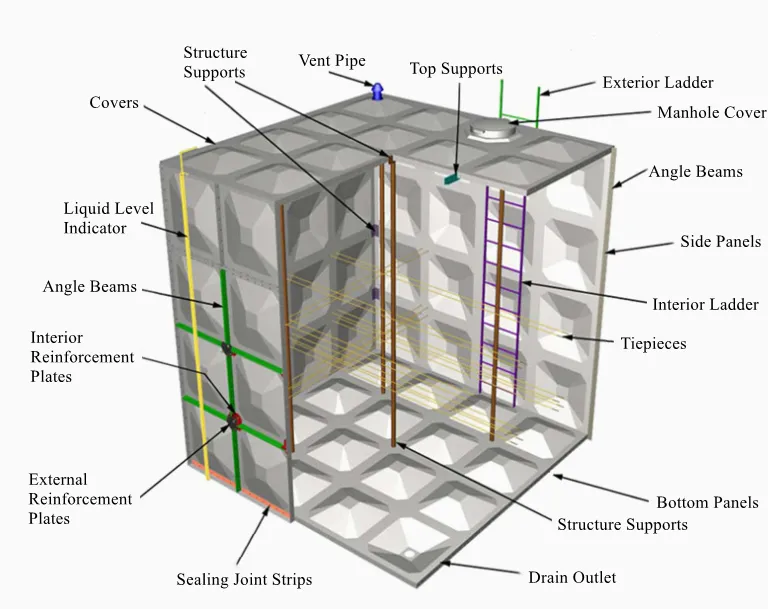loading...
- No. 9, Xingyuan South Street, Dongwaihuan Road, Zaoqiang County, Hengshui, Hebei, China
- admin@zjcomposites.com
- +86 15097380338
- Welcome to visit our website!
frp bridge deck panels
The Advantages of FRP Bridge Deck Panels
Fiber Reinforced Polymer (FRP) bridge deck panels are becoming increasingly popular in the construction and rehabilitation of bridges across the world. These innovative materials offer numerous advantages over traditional concrete and steel. As engineers and construction professionals seek durable, lightweight, and sustainable materials, the application of FRP in bridge decks presents a transformative solution.
What is FRP?
FRP is a composite material made from a polymer matrix reinforced with fibers, typically glass, carbon, or aramid. The combination of these materials yields a product that boasts exceptional strength-to-weight ratios, corrosion resistance, and design flexibility. In the context of bridge decks, FRP panels provide a strong yet lightweight alternative to conventional materials, significantly impacting construction methods and long-term maintenance.
Lightweight Structure
One of the most significant benefits of FRP bridge deck panels is their lightweight nature. Traditional concrete decks can be incredibly heavy, requiring substantial support structures and increasing the complexity and cost of bridge construction. In contrast, FRP panels are significantly lighter, allowing for reduced load on existing bridge components and potentially eliminating the need for additional reinforcement. This lightweight characteristic also facilitates easier transportation and installation, enabling quicker project completion and lower labor costs.
Corrosion Resistance
One of the major drawbacks of traditional materials is their susceptibility to corrosion, particularly in environments exposed to harsh weather or de-icing chemicals. Steel and concrete can degrade over time, leading to structural deficiencies and necessitating costly repairs. FRP panels, on the other hand, exhibit excellent resistance to moisture, salt, chemicals, and even UV radiation. This inherent durability translates to longer life spans for the bridge decks, reducing the frequency and cost of maintenance over the years.
Design Flexibility
frp bridge deck panels

The versatility of FRP materials offers architects and engineers considerable design freedom. FRP bridge deck panels can be manufactured in various shapes, sizes, and colors, allowing for aesthetic considerations that enhance the overall appeal of the bridge. Additionally, the capability to create tailored solutions means that FRP panels can be optimized for specific loading requirements and environmental conditions, further enhancing the performance of the bridge.
Sustainability
As society becomes increasingly aware of the importance of sustainable practices, the use of FRP in bridge construction aligns well with green building principles. The production of FRP materials often involves less energy than the production of traditional concrete and steel, and the extended life span of FRP reduces the need for frequent replacements and repairs. Furthermore, many FRP materials can be recycled or reused, contributing to reduced waste in construction projects.
Safety and Performance
The performance characteristics of FRP materials contribute significantly to the safety of bridge structures. FRP panels are non-conductive and do not rust, which eliminates common electrical and thermal hazards associated with traditional materials. Their design can also incorporate features that enhance frictional properties, providing better traction for vehicles, especially in wet conditions.
Case Studies and Applications
Several cities around the world have adopted FRP bridge deck panels in recent years. For instance, the use of these materials in pedestrian bridges has successfully combined aesthetics with functionality, showcasing how modern engineering can enhance public infrastructure. Additionally, FRP materials have been utilized in the rehabilitation of aging bridges, allowing for quick, effective retrofitting without needing extensive disruption.
Conclusion
The integration of FRP bridge deck panels into infrastructure projects presents numerous advantages, making them a compelling choice for contemporary bridge construction and rehabilitation. Their lightweight design, durability, corrosion resistance, and aesthetic flexibility position them as a forward-thinking alternative to traditional materials. As the construction industry continues to evolve, the adoption of FRP technology holds the promise of creating safer, more efficient, and sustainable bridge systems that meet the needs of present and future generations. By embracing these innovative materials, engineers can ensure that bridges not only meet current demands but also stand the test of time.
-
GRP Structures: The Future of Lightweight, High-Performance EngineeringNewsJun.20,2025
-
FRP Water Tank: High-Performance Storage for Corrosive and Clean Water SystemsNewsJun.20,2025
-
FRP Square Tube: The New Industry Standard for Chemical and Structural ApplicationsNewsJun.20,2025
-
FRP Pultruded Profiles: The Ultimate Choice for Lightweight Structural StrengthNewsJun.20,2025
-
FRP Handrails: The Safer, Smarter, and Stronger Choice for Modern InfrastructureNewsJun.20,2025
-
FRP Grating: The Smart Solution for Durable, Lightweight Industrial FlooringNewsJun.20,2025
-
Why Choose a Galvanized Water Tank for Your Storage NeedsNewsMay.21,2025
